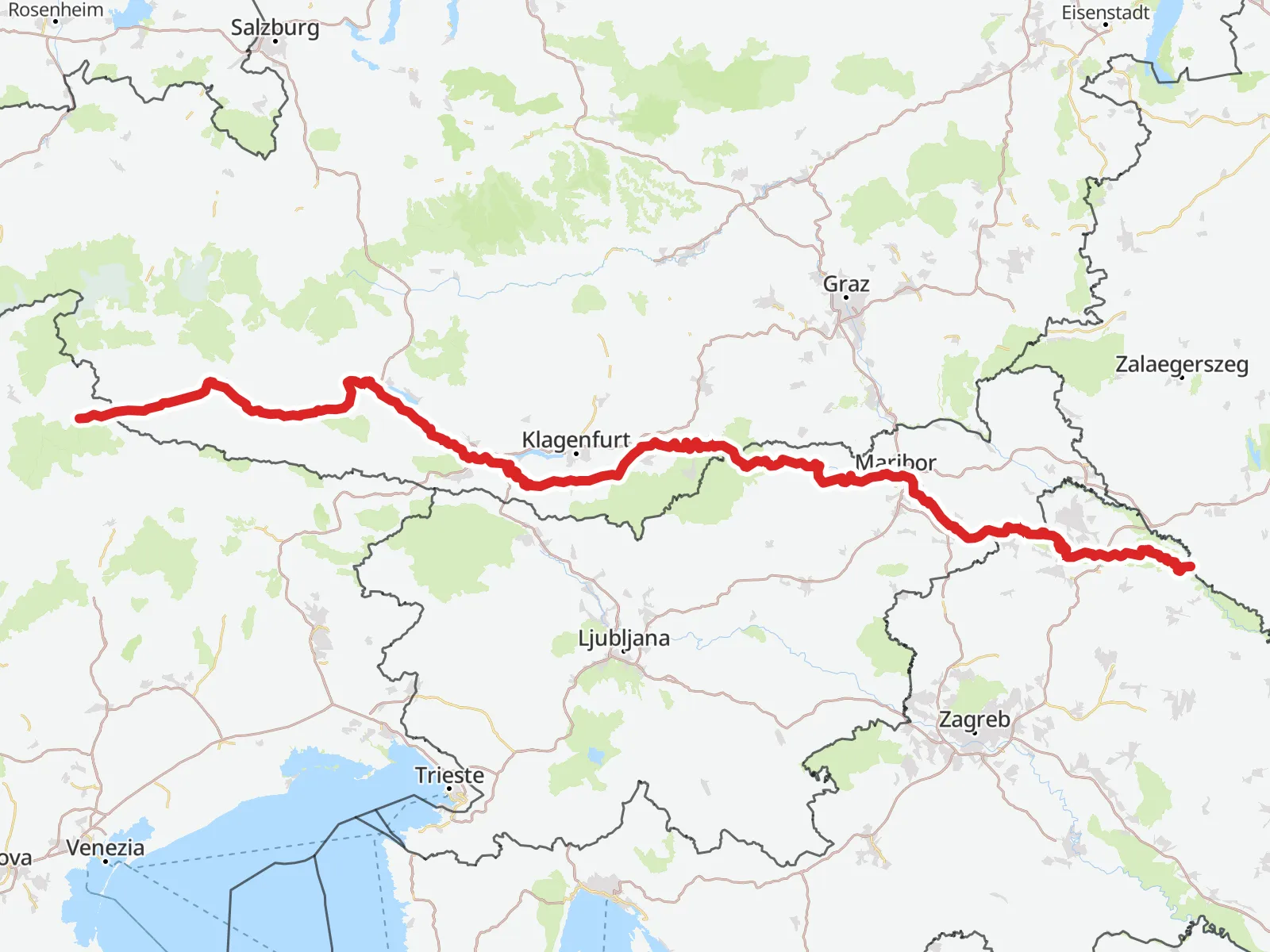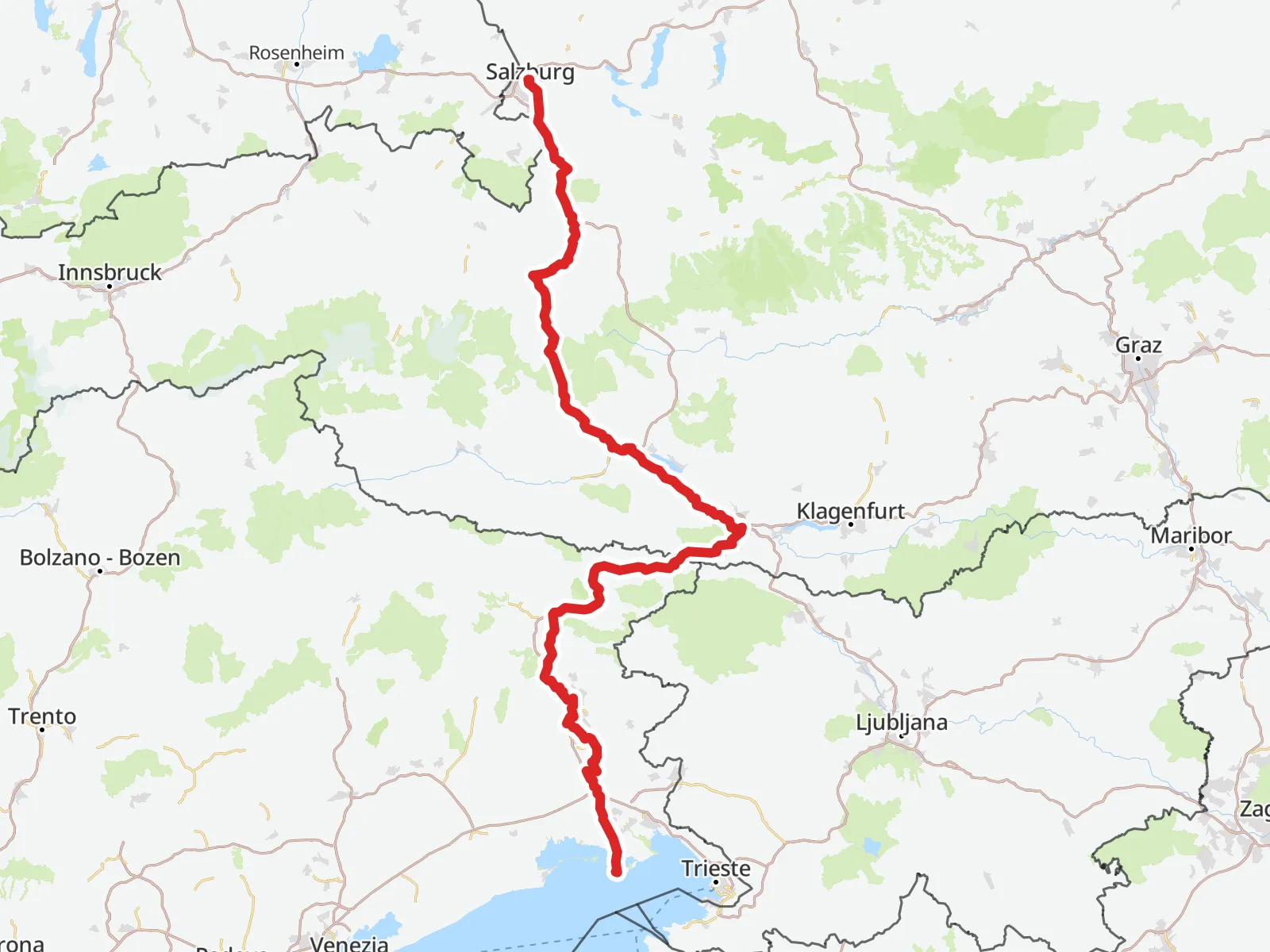Murradweg
The Murradweg stands as one of the most captivating river cycling routes in the Alpine region, following the Mur River through an extraordinary tapestry of landscapes and cultures. Beginning at the Sticklerhütte in Austria's Hohe Tauern National Park, this route winds through the entire state of Styria before crossing into Slovenia and concluding in Croatia. The journey encompasses dramatic mountain scenery, medieval trading towns, the cultural richness of Graz, and the vine-covered hills of southern Styria, creating an unforgettable cycling experience that balances natural beauty with cultural discovery.

From its source beneath the towering peaks of the Ankogel range, the Mur guides cyclists through diverse terrain that tells the story of Central Europe. The route passes through historic brewing towns like Murau, industrial heritage sites in Leoben, and the UNESCO World Heritage city of Graz before reaching the thermal spa destination of Bad Radkersburg at the Slovenian border.
Essential Route Information
- Difficulty: Medium in northern sections, easy from Graz southward
- Elevation profile: Mountainous terrain in the north with significant descents, predominantly flat through central and southern sections
- Surface types: Well-maintained asphalt and compacted cycling paths with occasional quiet secondary roads
- Route type: Dedicated cycle paths and low-traffic roads with excellent separation from motor traffic
- Recommended direction: North to south following the river's natural flow
- Recommended bike: Touring or hybrid bicycles; road bikes suitable for most sections
- Certification: Part of the Austrian long-distance cycling network
Route Marking & Navigation
The Murradweg features excellent waymarking consistency throughout Austria with distinctive green signs bearing white "R 2 Murradweg" text. Navigation remains straightforward as the route closely follows the river's path, minimizing opportunities for wrong turns. In Graz, the signage changes to white signs with green "R 2" markings, maintaining clear directional guidance through the urban environment.
The quality of waymarking remains consistently high across all Austrian sections, with regular confirmation signs providing reassurance at key decision points. International border crossings are clearly marked, and the route seamlessly continues with appropriate signage in Slovenia and Croatia.

Best Direction & Season
The north-to-south direction proves optimal, allowing cyclists to benefit from the natural descent while following the river's flow toward its destination. This orientation also provides the most logical progression from alpine landscapes to Mediterranean-influenced wine country.
- Peak season: May through September with warmest conditions
- Optimal months: June to August for mountain sections and thermal spa access
- Spring riding: April and May offer blooming landscapes with mild temperatures
- Autumn cycling: September and early October provide harvest season atmosphere in wine regions
Main Stages & Highlights
The route naturally divides into distinct stages, each offering unique character and attractions that reflect the changing landscape and cultural influences.
Sticklerhütte to St. Michael im Lungau: A dramatic introduction featuring alpine scenery and the source of the Mur River. The initial descent requires careful attention, particularly at the Arsenhütte hairpin turn and the curved section at Jedl.
St. Michael im Lungau to Murau: This stage introduces the historic Murtalbahn railway and passes through Tamsweg with its important pilgrimage church of St. Leonhard. The route culminates in medieval Murau with its brewery heritage and impressive castle.
Murau to Judenburg: Cyclists traverse the Niedere Tauern foothills while accompanied by the narrow-gauge Murtalbahn. Highlights include the legendary Frauenburg ruins and Judenburg's remarkable 76-meter town tower housing Austria's highest planetarium.
Judenburg to Leoben: The route passes through the Zirbenland region with opportunities to visit the Red Bull Ring and Aqualux thermal spa. Leoben welcomes cyclists with its Göss Monastery brewery and the famous "largest beer garden in Austria" at the main square.
Leoben to Graz: Perhaps the most scenically diverse stage, featuring the historic trading town of Bruck an der Mur, the dramatic Bärenschützklamm gorge, and the fascinating Lurgrotte cave system. The open-air museum at Stübing provides insight into traditional Alpine architecture before reaching Styria's capital.
Graz to Leibnitz: The transition from urban culture to wine country begins as cyclists traverse the Grazer Feld agricultural region. Leibnitz offers access to Schloss Seggau with its 300-year-old wine cellars and proximity to the elevated wine village of Kitzeck.
Leibnitz to Bad Radkersburg: The final Austrian stage showcases the Natura 2000 Murauen wetlands and includes unique attractions like the historic Mureck ship mill. Bad Radkersburg provides thermal spa relaxation and marks the gateway to Slovenia.
Key Attractions Along the Route
The Murradweg connects an impressive collection of natural wonders, cultural sites, and recreational facilities that justify extended stops and exploration.
Historical & Cultural Sites:
- Hohe Tauern National Park with Mur River source
- St. Leonhard pilgrimage church in Tamsweg
- Medieval Murau with Brauerei der Sinne (Brewery of the Senses)
- Judenburg's Sternenturm Planetarium
- Graz UNESCO World Heritage Old Town and Schloss Eggenberg
- Bruck an der Mur's historic main square and castle hill
- Freilichtmuseum Stübing open-air museum
- Bad Radkersburg's preserved medieval town center
Natural Attractions:

- Bärenschützklamm gorge with suspension walkways
- Lurgrotte - Austria's largest water-filled stalactite cave
- Murecker Schiffsmühle historic ship mill
- Natura 2000 Murauen wetland preserve
- Multiple swimming lakes including Wildoner Badesee and Röcksee
Recreational Facilities:
- Red Bull Ring racing circuit with visitor attractions
- Aqualux Therme Fohnsdorf thermal spa
- Parktherme Bad Radkersburg thermal complex
- Märchenwald family adventure park
Culinary Highlights
The Murradweg traverses regions renowned for distinct culinary traditions that reflect both Alpine heritage and Mediterranean influences. The northern sections celebrate traditional Austrian mountain cuisine, while southern areas showcase innovative wine country gastronomy and the famous Styrian pumpkin seed oil.
Regional Specialties:
- Styrian pumpkin seed oil (Kürbiskernöl) - liquid gold of the region
- Käferbohne (Styrian scarlet runner beans) with regional preparations
- Traditional mountain cheeses and Alpine dairy products
- Schilcher rosé wine from the western hills
- Traminer and Sauvignon Blanc wines from southern vineyards
- Murauer beer and other regional brewery specialties
- Fresh-pressed apple juices and traditional schnapps
The route features numerous establishments holding prestigious culinary certifications including Guide Michelin stars, Gault Millau ratings, and Kulinarium Steiermark designations. Wine enthusiasts will particularly appreciate the Vinofaktur Genussregal in Vogau, which showcases regional products in an immersive market hall setting.
Accommodation Options
The Murradweg offers comprehensive accommodation networks with particular strength in cyclist-friendly services. The route benefits from numerous Bett+Bike certified establishments that provide specialized facilities for touring cyclists.
- Bett+Bike certified hotels: Secure bike storage, repair kits, early breakfast options, and weather protection
- Traditional gasthaus accommodation: Family-run establishments with regional cuisine and local insights
- Camping facilities: Well-equipped sites at strategic locations including Fisching and various lakeside positions
- Thermal spa hotels: Luxury options in Fohnsdorf and Bad Radkersburg combining cycling with wellness
- Urban accommodations: Full range of options in Graz and other major towns
Access & Transportation
Getting There: The northern starting point requires combination transport, with rail service available to Tamsweg via the scenic Murtalbahn from Unzmarkt. From Tamsweg, bus connections reach St. Michael im Lungau, though advance bicycle reservations are required. Free parking is available in both Muhr im Lungau and St. Michael im Lungau for those arriving by car.
Getting Back: Multiple return options accommodate different preferences and destinations. The comprehensive ÖBB rail network provides connections from most route towns back to starting points. Bacher Reisen operates a specialized bicycle shuttle service from Bad Radkersburg to St. Michael im Lungau, requiring advance booking. For international extensions into Slovenia and Croatia, Gästehaus Rosi in Bad Radkersburg offers return shuttle services to the Austrian border.
The historic Murtalbahn deserves special mention for offering free bicycle transport on steam trains between June and September, adding a memorable element to the cycling experience.
Practical Considerations
Road cyclists should note that most of the Austrian route features excellent asphalt surfaces, though the initial descent from Sticklerhütte toward Muhr requires wider tires due to gravel sections. The Biosphärenpark Murauen section near the Slovenian border also features compressed gravel surfaces that may challenge narrow road bike tires.
Service infrastructure proves excellent throughout the Austrian sections:
- Bicycle shops available in all major towns along the route
- 24-hour repair stations with tools and pumps at regular intervals
- Abundant water sources and rest facilities during summer months
- ATM and grocery access in most villages
- Tourist information centers providing maps and local guidance
Weather patterns can vary significantly between the alpine start and Mediterranean-influenced finish. Mountain sections may experience rapid weather changes even in summer, while southern areas generally offer more stable conditions. The GenussCard provides valuable benefits for the Leibnitz to Bad Radkersburg section, offering free admission to over 280 attractions when staying at participating accommodations.
Final Tips
The Murradweg rewards cyclists who balance efficient progress with cultural curiosity. Plan for 8-10 days including adequate time for major attractions like the Bärenschützklamm, Graz exploration, and wine region detours. The route's excellent infrastructure allows flexible daily stages, though booking accommodations in advance ensures optimal cycling-specific services.
For those seeking extended Central European cycling experiences, the Murradweg connects seamlessly with other major routes. The EuroVelo 9 continues through Bad Radkersburg, while the Mürztalradweg joins at Bruck an der Mur, creating opportunities for longer touring adventures. The international continuation through Slovenia and Croatia offers additional cultural dimensions for adventurous cyclists willing to explore beyond Austria's borders.






